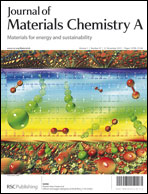Effect of structure on the solubility and photovoltaic properties of bis-diketopyrrolopyrrole molecules†
Abstract
Four structurally related molecules consisting of two diketopyrrolopyrrole (DPP) units linked via a terthiophene aromatic π-bridge were synthesized and blended with [70]PCBM in solution-processed small-molecule organic solar cells. The four bis-DPP molecules possess nearly identical optical band gaps and energy levels, but their solubility differs significantly. The processing conditions, such as the solvent, processing additive, and total concentration, have a significant effect on the device performance. The bis-DPP derivative with the lowest solubility gives the highest power conversion efficiency (PCE) of 4.6% when blended with [70]PCBM, compared to 3.6–4.0% for the other three. The results show that subtle changes and tailoring of the molecular structure can strongly affect the solubility and, in turn, the processing conditions leading to the optimized device performance and its ultimate PCE.


 Please wait while we load your content...
Please wait while we load your content...